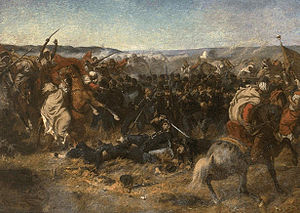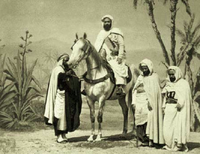Battle of Sidi Brahim
You can help expand this article with text translated from the corresponding article in French. (September 2023) Click [show] for important translation instructions.
|
| Battle of Sidi Brahim | |||||||
|---|---|---|---|---|---|---|---|
| Part of the French conquest of Algeria | |||||||
 Battle of Sidi Brahim by Louis-Théodore Devilly. | |||||||
| |||||||
| Belligerents | |||||||
|
|
| ||||||
| Commanders and leaders | |||||||
|
Lucien de Montagnac † Captain Dutertre † Captain de Géreaux † | Emir Abdelkader | ||||||
| Strength | |||||||
| 500[1] | c. 3,000[2][disputed – discuss] | ||||||
| Casualties and losses | |||||||
| 350 killed, c. 100 captured [a][disputed – discuss] | Unknown | ||||||
The Battle of Sidi Brahim, 22 to 25 September 1845, took place during the French conquest of Algeria, near Sidi Brahim. Algerian forces under Emir Abdelkader surprised a French detachment of 500 led by Lieutenant-Colonel Lucien de Montagnac. Most of the latter were killed or captured in the initial fighting, and only eleven were reported to have ultimately survived the encounter.
Despite their defeat, the French used the battle as a symbol of the price paid to acquire French Algeria, and in 1898, a monument to the "martyrs of Sidi-Brahim" was installed in Oran. After Algerian independence in 1962, the monument was transformed into one commemorating Emir Abdelkader, and anti-colonial resistance in general.
Background
[edit]The French conquest of Algeria began with the capture of Algiers in 1830, and over the next decade expanded along the coast. In 1840, three French provinces were created, Constantine in the east, Alger in the centre, and Oran in the west. However, intense guerrilla fighting continued in the interior, which in western Algeria was led by Emir Abdelkader. Although isolated French detachments were still vulnerable to surprise attacks, by 1845 a ruthless scorched earth policy employing small numbers of fast moving troops had eliminated most of the remaining resistance.[3]
In September 1845, Lieutenant-Colonel Lucien de Montagnac, commander of the garrison at Ghazaouet, received news Abdelkader was in the area, and set out to intercept him with a mixed force of 400 to 500 cavalry and light infantry. Allegedly unpopular with his troops, Montagnac was a hard-bitten colonial veteran, whose "own writings boast of several war crimes".[4]
Battle
[edit]The encounter was unplanned and poorly commanded by Montagnac, and went badly for the French troops. After a first encounter, the French's numbers were reduced from 450 to 82 chasseurs and hussars against hundreds of Algerians. Cornered, the chasseurs of the carabinier company took refuge in a marabout, from which they repulsed all assaults.
After a siege lasting many days, without food or water and short of munitions, they were reduced to cutting up their musket balls in order to keep firing. Emir Abdelkader captured captain adjutant major Dutertre and taken under guard to the front of the marabout to demand the chasseurs' surrender, but instead used his time there to exhort the survivors to fight to the death, for which Abdelkader beheaded him. Abdelkader then demanded that the French bugler (Guillaume Rolland) sound the retreat, but he instead sounded the charge, whilst one chasseur replied to another of Abdelkader's other demands for their surrender with the word, Merde! (Shit). (in reference to Cambronne's answer at Waterloo). When the remaining 80 survivors completely ran out of munitions, they managed to break through the enemy lines with a bayonet charge, but only 16 of them managed to rejoin the French lines (5 of which died some days later). Among the dead was Montagnac himself. The remains of the soldiers killed at Sidi Brahim were gathered at Djemmaa Ghazaouet in the "Tombeau des Braves" then reburied at the Musée des Chasseurs at the old fort in Vincennes in 1965.
Legacy
[edit]
Some 100 French prisoners taken at Sidi Brahim were marched into Morocco, along with another 160 captured the following week near Aïn Témouchent. The majority of these were executed in April 1846.[5] Despite their defeat, the French used the battle as a symbol of the "blood sacrifice" paid to create French Algeria. In 1898, a monument to the "martyrs of Sidi-Brahim" was erected in Oran, but after Algerian independence in 1962, it was transformed into one of anti-colonial resistance, and the nationalist hero, Emir Abdelkader. Parts of the original monument were removed, including the statue of Marianne, which can now be seen in the village of Périssac, birthplace of Captain de Géreaux, who died in the fighting.[6]
Footnotes
[edit]- ^ The prisoners were marched into Morocco, along with another 160 taken at Sidi Moussa the following week. The majority were executed in April 1846
References
[edit]- ^ Holstein 2019, p. 16.
- ^ Garnier 2004, p. 37.
- ^ Horne 1977, pp. 29–30.
- ^ Manceron 2003, p. 168.
- ^ Marin 1847, pp. 7–12.
- ^ Ivey, Beatrice. "The Sidi-Brahim monument". Narratives and Representations of the French Settlers of Algeria. University of Stirling. Retrieved 28 December 2024.
Sources
[edit]- Garnier, Jacques (2004). Dictionnaire Perrin des guerres et des batailles de l'histoire de France (in French). Perrin. ISBN 9782262008291.
- Horne, Alistair (1977). A Savage War of Peace; Algeria 1954-1962 (1996 ed.). Papermac. ISBN 978-0333669518.
- Holstein, Christine (2019). Walking In the Footsteps of the Fallen Verdun 1916. Pen and Sword Military. ISBN 978-1-5267-1707-8.
- Manceron, Gilles (2003). Marianne et les colonies (in French). La découverte. ISBN 978-2707138798.
- Marin, John Joseph (1847). Défense du lieutenant Marin devant le Conseil d'enquête de Perpignan, le 4 septembre 1847 (in French). Felix Mateste. Retrieved 2 January 2025.
External links
[edit]- Les Zouaves et les Chasseurs a Pied, Duc d'Aumale, Henri d'Orléans - pseudonym - M. Lévy frères - 1859 - 184 pages
- Sidi-Brahim - 23, 24, 25 et 26 septembre 1845, Esquisse Historique - Charleville - Imprimerie Nouvelle - 1889 - 58 pages
35°15′38″N 0°34′03″W / 35.2606°N 0.5675°W


